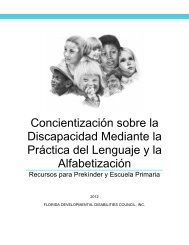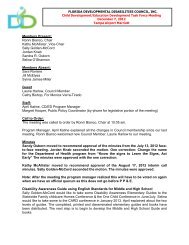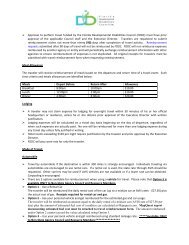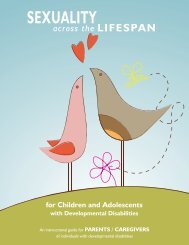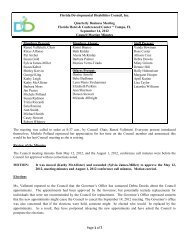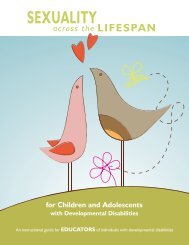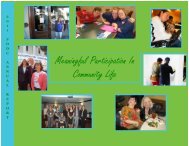Planning Ahead - Florida Developmental Disabilities Council
Planning Ahead - Florida Developmental Disabilities Council
Planning Ahead - Florida Developmental Disabilities Council
- No tags were found...
You also want an ePaper? Increase the reach of your titles
YUMPU automatically turns print PDFs into web optimized ePapers that Google loves.
medication or behavior programs directed at the behavior is not in the person’s best interestunless the situation causing the behavior is first addressed.Sometimes a person with retardation may not react immediately to a severe loss. Therefore, thefamily or a caregiver may not always recognize that an unexplained sadness, despondency orinappropriate behavior is relative to a death or other severe loss that occurred in the past.Remember that grieving takes time. This period can last from a few weeks to years. Be patientand understanding. The best way to help a person through such a loss is to recognize the loss,understand his feelings, and help him express them. With this knowledge and support the painof grief will gradually diminish. There are things you can do to help the person with retardationcope with changes and loss.• Tell the individual immediately when a family member or friend dies. Be sensitivein selecting who informs him and how it is done. Remember that abstract thoughtsare difficult for him to understand, so be as concrete as possible in describing whatdeath means.• Encourage the individual to participate in any family rituals, e.g., attending thewake, the funeral and interacting with family and visitors.• Allow the person to express as much grief as he is comfortable sharing. Remember,grieving takes time – weeks, months, and even years.• Communicate with the person on a consistent basis about the acceptability ofgrieving. Don’t avoid the person, or change the subject when dying or loss is mentioned.• Be patient. The individual’s progress may be erratic, and include times of confusion,forgetfulness, or denial.• Communicate in a way and on the level that the person can understand. Recallpleasant times together that they have shared.• Realize that one person’s death may remind the individual of previous losses andunresolved grief.• If possible, call upon an appropriate spiritual advisor who recognizes the need togrieve and is experienced in relating to persons with disabilities.If your family member does not live with your family, but is in a residential facility, discuss withstaff and friends what has happened and encourage them to talk with him about his sadnessand about the deceased person and their relationship. You will need to be a good listener as hetries to express his feelings. If the policy of the residential facility has been to avoid discussingdeath and grieving, encourage them to initiate a learning experience for the group.PROVIDING LEARNING OPPORTUNITIESTeaching about life and death may be done individually at a time that is appropriate, or in smallgroups as part of a continuing project. Suggestions for these activities are:• Explain that death is the final outcome of the aging process for all of us. It is a partof life. Show that fatal injuries and incurable diseases can shorten life.Chapter 11, Coping with Changes & Losses51



